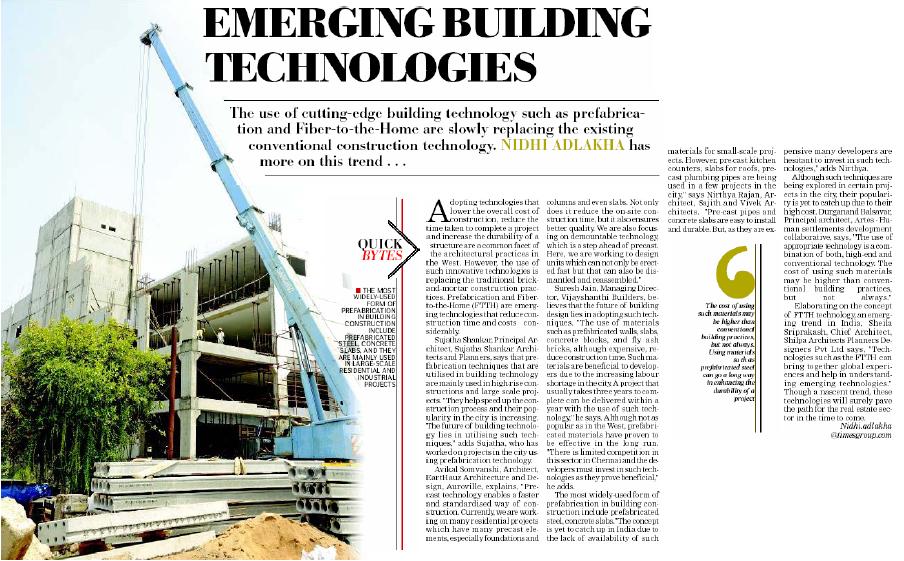Times of India, 21 Apr 2012: EMERGING BUILDING TECHNOLOGIES
The use of cutting-edge building technology such as prefabrication and Fiber-to-the-Home are slowly replacing the existing conventional construction technology. NIDHI ADLAKHA has more on this trend . . .
Adopting technologies that lower the overall cost of construction, reduce the time taken to complete a project and increase the durability of a structure are a common facet of the architectural practices in the West. However, the use of such innovative technologies is replacing the traditional brickand-mortar construction practices. Prefabrication and Fiberto-the-Home (FTTH) are emerging technologies that reduce construction time and costs considerably.
Sujatha Shankar, Principal Architect, Sujatha Shankar Architects and Planners, says that prefabrication techniques that are utilised in building technology are mainly used in high-rise constructions and large scale projects. “They help speed up the construction process and their popularity in the city is increasing. The future of building technology lies in utilising such techniques,” adds Sujatha, who has worked on projects in the city using prefabrication technology.
Avikal Somvanshi, Architect, EartHauz Architecture and Design, Auroville, explains, “Precast technology enables a faster and standardised way of construction. Currently, we are working on many residential projects which have many precast elements, especially foundations and columns and even slabs. Not only does it reduce the on-site construction time, but it also ensures better quality. We are also focusing on demountable technology, which is a step ahead of precast. Here, we are working to design units which can not only be erected fast but that can also be dismantled and reassembled.”
Suresh Jain, Managing Director, Vijayshanthi Builders, believes that the future of building design lies in adopting such techniques. “The use of materials such as prefabricated walls, slabs, concrete blocks, and fly ash bricks, although expensive, reduce construction time. Such materials are beneficial to developers due to the increasing labour shortage in the city. A project that usually takes three years to complete can be delivered within a year with the use of such technology,” he says. Although not as popular as in the West, prefabricated materials have proven to be effective in the long run. “There is limited competition in this sector in Chennai and the developers must invest in such technologies as they prove beneficial,” he adds.
The most widely-used form of prefabrication in building construction include prefabricated steel, concrete slabs.”The concept is yet to catch up in India due to the lack of availability of such materials for small-scale projects. However, precast kitchen counters, slabs for roofs, precast plumbing pipes are being used in a few projects in the city,” says Nirthya Rajan, Architect, Sajith and Vivek Architects. “Pre-cast pipes and concrete slabs are easy to install and durable. But, as they are expensive many developers are hesitant to invest in such technologies,” adds Nirthya.
Although such techniques are being explored in certain projects in the city, their popularity is yet to catch up due to their high cost. Durganand Balsavar, Principal architect, Artes – Human settlements development collaborative, says, “The use of appropriate technology is a combination of both, high-end and conventional technology. The cost of using such materials may be higher than conventional building practices, but not always.”
Elaborating on the concept of FTTH technology, an emerging trend in India, Sheila Sriprakash, Chief Architect, Shilpa Architects Planners Designers Pvt Ltd says, “Technologies such as the FTTH can bring together global experiences and help in understanding emerging technologies.” Though a nascent trend, these technologies will surely pave the path for the real estate sector in the time to come.



